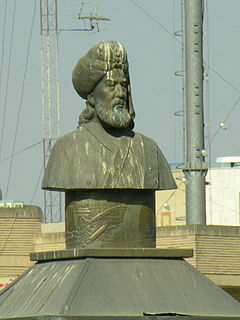 W
WAbarsam was a high-ranking officer in Sasanian Iran, who served as the minister of king Ardashir I.
 W
WAzen Gushnasp was an Iranian statesman who served as the minister of the Sasanian king Hormizd IV from an unknown date till his death in 590.
 W
WBozorgmehr-e Bokhtagan, also known as Burzmihr, Dadmihr and Dadburzmihr, was an Iranian sage and dignitary from the Karen family, who served as minister of the Sasanian king (shah) Kavad I, and the latter's son and successor Khosrow I. He also served as the military commander (spahbed) of Khwarasan under Khosrow I and his successor Hormizd IV. According to Persian and Arabic sources, Bozorgmehr was a man of "exceptional wisdom and sage counsels" and later became a characterisation of the expression. His name appears in several important works in Persian literature, most notably in the Shahnameh. The historian Arthur Christensen has suggested that Bozorgmehr was the same person as Borzuya, but historigraphical studies of post-Sasanian Persian literature, as well as linguistic analysis show otherwise. However, the word "Borzuya" can sometimes be considered a shortened form of Bozorgmehr.
 W
WFarrukh Hormizd or Farrokh Hormizd, also known as Hormizd V, was an Iranian prince, who was one of the leading figures in Sasanian Iran in the early 7th-century. He served as the military commander (spahbed) of northern Iran. He later came in conflict with the Iranian nobility, "dividing the resources of the country". He was later killed by Siyavakhsh in a palace plot on the orders of Azarmidokht after he proposed to her in an attempt to usurp the Sasanian throne. He had two children, Rostam Farrokhzad and Farrukhzad.
 W
WIzadgushasp, known in Byzantine sources as Isdigousnas Zikh, was an Iranian nobleman from the House of Mihran, who served as one of Khosrow I's viziers.
 W
WMihr-Narseh, was a powerful Iranian dignitary from the House of Suren, who served as minister of the Sasanian shahanshahs Yazdegerd I, Bahram V, Yazdegerd II and Peroz I. According to the Iranologist Richard N. Frye, Mihr-Narseh was the "prototype of the later Islamic grand vizier."
 W
WSukhra was an Iranian nobleman from the House of Karen, who was the de facto ruler of the Sasanian Empire from 484 to 493. He was active during the reign of shah Peroz I, Balash and Kavad I. He is often confused with his father Zarmihr Hazarwuxt and son Zarmihr Karen.